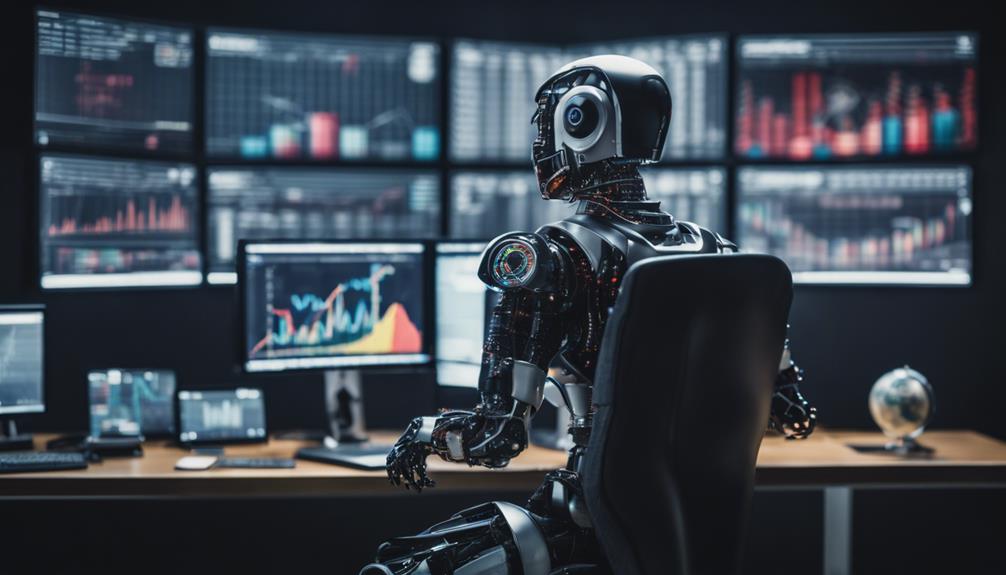In the era of steam engines and telegraphs, the concept of automated Forex trading would have seemed like sorcery. Yet, here you are, navigating the complexities of digital markets with algorithms that execute trades at the speed of light.
You’ve likely observed the precision and efficiency these systems bring, alongside their ability to operate devoid of emotional biases. However, you’re also aware that technical glitches and over-optimization pose significant risks, potentially leading to substantial losses.
As you weigh the benefits against the drawbacks, it becomes evident that choosing the right platform and maintaining a balance between algorithmic and manual oversight could be the linchpin for success in this volatile arena.
This raises the question: How can you effectively harness the power of automation while mitigating its pitfalls?
Key Takeaways
- Automated Forex trading offers 24/7 market access and emotion-free decision making.
- Risks include technical glitches and the potential for poor real-time performance due to over-optimization.
- Performance analysis shows automation excels in precision, speed, and strategy optimization over manual trading.
- Future trends point to incorporating advanced technologies like machine learning for improved trading strategies.
Defining Automated Forex Trading

Automated Forex trading, also known as algorithmic trading, utilizes computer algorithms to execute trades in the Forex market autonomously. You’re diving into a world where precision and efficiency aren’t just goals—they’re requisites. In this realm, algo trading stands out by analyzing market data in real-time, identifying lucrative trading opportunities without a hint of delay, and executing buy or sell orders based on meticulously predefined criteria.
What sets automated Forex trading apart is its capability to operate round the clock. It’s designed to leverage opportunities across various time zones, ensuring that no profitable trade slips through due to human limitations like sleep or inattention. This 24/7 operation, coupled with rapid trade execution, maximizes your chances of success in the dynamic Forex market.
Furthermore, by sidelining emotional biases—a common pitfall for many traders—automated systems aim to bring a level of consistency and objectivity to trading that’s hard to achieve manually. The added feature of backtesting allows you to refine your trading strategies against historical data, providing a robust framework for assessing their potential effectiveness before risking capital in live markets. Through automated Forex trading, you’re not just participating in the market; you’re approaching it with a calculated precision designed to enhance your trading performance.
The Evolution of Automation in Trading
Over the years, the integration of automation into trading has fundamentally transformed financial markets, enhancing both the accuracy and speed of trade executions. You’ve witnessed this shift as automated forex trading systems have taken center stage, minimizing emotional biases and fostering objective decision-making. This transformation hasn’t just improved trade execution; it’s revolutionized how strategies are developed and optimized.
| Evolution Aspect | Impact on Trading |
|---|---|
| Reduction of Emotional Biases | Leads to more consistent and objective trading outcomes. |
| Backtesting Capabilities | Enables strategy optimization using historical data. |
| 24/7 Trading Availability | Offers continuous access to global markets. |
The ability to backtest strategies using vast amounts of historical data is a game-changer. It allows you to refine and adapt your trading approach with precision, enhancing your strategy’s performance over time. Moreover, the diversification made possible through automated systems helps in risk management by spreading investments across various assets.
As you delve further into the world of trading, understanding the evolution of automation is crucial. It’s not just about keeping pace; it’s about leveraging these advancements to your advantage, ensuring you’re equipped with the best tools for effective decision-making in the fast-paced forex market.
Key Benefits of Automation
Exploring the core advantages of automation reveals how its implementation elevates trading efficiency, accuracy, and profitability. When you delve into the pros of automated Forex trading, several key benefits stand out, each contributing to a more streamlined and effective trading process. Here’s a closer look:
- Speed and Efficiency: Automated trading ensures the precise and speedy execution of trades, significantly minimizing delays and slippage. This aspect is crucial in the fast-paced Forex market where even microseconds matter.
- Emotion-free Decision Making: One of the most significant advantages is the elimination of human biases. Automated systems make decisions based on pre-set criteria, ensuring objectivity and consistency in trading actions.
- Backtesting Capabilities: Before applying a strategy live, you can use historical data to assess its performance. This ability to backtest strategies with a high degree of accuracy is invaluable for strategy optimization.
- 24/7 Trading Across Time Zones****: With automated systems, the market’s continuous nature becomes an advantage rather than a challenge. Your trading doesn’t have to stop due to sleep or geographical location, enabling a truly global trading approach.
Common Pitfalls and Risks

While automated Forex trading offers numerous benefits, it’s crucial to be aware of its inherent pitfalls and risks that could undermine your trading success. Over-optimization of trading strategies based on historical data can lead to poor performance in real-time trading scenarios. This phenomenon occurs when a strategy is overly fine-tuned to past conditions, making it less adaptable and potentially ineffective during unexpected market shifts.
Moreover, technical glitches and software errors are significant risks in automated trading systems. These issues can trigger unexpected losses, underscoring the importance of robust system testing and reliable technology. Additionally, a lack of adaptability to changing market conditions may limit the effectiveness of your automated strategies. As markets evolve, a static approach can quickly become obsolete, highlighting the need for continuous strategy evaluation and adjustment.
Connectivity issues also pose a risk, as they can disrupt trade execution and impact the performance of automated systems. Ensuring high-quality data is crucial for accurate decision-making and risk management in automated trading. Inaccurate or incomplete data can lead to misguided trades, emphasizing the importance of reliable data sources and infrastructure to mitigate these risks effectively.
Performance Analysis: Automated Vs. Manual
Frequently, automated trading systems outperform manual ones due to their ability to execute trades with unparalleled precision and speed, effectively minimizing human errors and emotional biases. When diving into the performance analysis of automated versus manual trading, it’s crucial to understand the inherent advantages and challenges of each approach.
Here’s a closer look:
- Precision and Speed: Automated systems execute trades at a speed and accuracy that manual trading can’t match, ensuring optimal entry and exit points are capitalized on.
- Emotional Detachment: By removing emotional decision-making, automated trading systems adhere strictly to predefined strategies, enhancing consistency across trades.
- Backtesting Capabilities: Automated systems excel in their ability to backtest strategies against historical data, providing a robust framework for strategy optimization and risk assessment.
- Market Coverage: Unlike manual traders, automated systems can monitor and trade multiple currency pairs across various time zones, maximizing trading opportunities and market exposure.
Understanding these aspects is vital for traders seeking to leverage the full potential of automated trading systems. The blend of speed, precision, and analytical depth offered by automation unmistakably sets a high benchmark in trading performance, challenging manual traders to innovate continuously.
Choosing the Right Automated System

Understanding the advantages and challenges of automated versus manual trading sets the stage for selecting the right automated system that aligns with your trading strategy and goals. As a Forex trader, you’re navigating through complex market conditions, and the right system can be your ally. Here’s what you need to consider:
| Factor | Why It Matters | What to Look For |
|---|---|---|
| Compatibility | Ensures the system matches your trading strategy and objectives. | Customization options and alignment with your goals. |
| Historical Performance | Offers insights into how the system performs under various conditions. | Verified track records and transparent performance data. |
| Usability and Support | Affects the ease of use and resolution of potential issues. | User-friendly interface and robust technical support. |
Evaluating the historical performance of an automated system is crucial; it provides a glimpse into how the system might perform under similar market conditions in the future. Look for systems with a track record of adapting to volatile markets, as these are indicators of resilience and reliability.
Moreover, don’t overlook the importance of a user-friendly interface and the availability of technical support. These factors ensure smooth operation and quick resolution of any issues, enabling you to maintain focus on your trading activities without unnecessary interruptions.
Strategies for Effective Automation

To effectively harness the power of automated trading, you must deploy a variety of strategies that cater to risk management and optimize performance. The precision and analytical rigor required can’t be overstated, as automated systems allow for unparalleled efficiency in executing strategies. Here’s how you can refine your approach:
- Diversify Automated Strategies: Implement a portfolio of diversified automated trading strategies. This mitigates risk by not putting all your eggs in one basket, allowing you to spread potential losses across different markets and strategies.
- Employ Backtesting Rigorously: Utilize backtesting tools comprehensively to evaluate the effectiveness of your strategies. This involves historical data analysis to predict how a strategy would have performed, ensuring your systems are robust before live implementation.
- Integrate Risk Management Protocols: Incorporate stop-loss orders and adhere to strict risk management protocols. Such mechanisms are essential in limiting potential losses and preserving capital within your automated systems.
- Monitor and Adjust in Real-Time: Keep a vigilant eye on market conditions and be prepared to make timely adjustments to your algorithms. Leveraging advanced technical indicators and algorithms for optimization is paramount, ensuring your strategies remain relevant and effective.
Mastering these strategies ensures your automated trading endeavors are both profitable and sustainable, making you adept in navigating the complexities of the forex market.
Future Trends in Automated Trading
Having explored strategies for effective automation, let’s now examine the evolving landscape of automated trading, focusing on the pivotal role of emerging technologies like machine learning and blockchain. You’re entering a realm where precision and swift adaptability aren’t just beneficial; they’re imperative. Machine learning algorithms are being intricately woven into automated trading systems, vastly enhancing decision-making capabilities. This isn’t just about analyzing historical data; it’s about predicting future market movements with a degree of accuracy previously deemed unattainable.
High-frequency trading (HFT) represents a significant shift in market dynamics, exploiting cutting-edge technology to execute trades at speeds that leave human traders in the dust. This is where artificial intelligence (AI) transitions from a futuristic concept to an essential tool, enabling systems to not just react to market changes but to anticipate them.
The integration of blockchain technology promises to redefine trade settlement processes, introducing unparalleled levels of security, transparency, and efficiency. Meanwhile, the horizon is brightened by the potential of quantum computing, poised to revolutionize automated trading by exponentially increasing the processing power available for complex algorithms. As you navigate these future trends, remember that mastery in this field requires not just understanding but anticipation of how these technologies will shape the landscape of automated trading.
Frequently Asked Questions
Does Automated Forex Trading Work?
Yes, automated Forex trading does work. It executes trades based on specific rules and algorithms, eliminating emotional bias. This ensures consistent, objective decisions.
Moreover, you can use backtesting to evaluate performance using historical data. It’s crucial to have a solid strategy, implement proper risk management, and regularly monitor and adjust your system.
What Are the Cons of Automated Trading?
You’re facing several cons when considering automated trading. Technical challenges in system development demand programming expertise and time. There’s a risk of over-optimizing for past data, leading to real-time strategy failures. Your success depends heavily on market behavior, with unexpected conditions often undermining system performance.
Additionally, a lack of adaptability to these conditions can severely limit effectiveness. Moreover, technical issues like glitches or connectivity problems can lead to significant financial losses.
Are Forex Robots Worth It?
Diving into whether forex robots are your golden goose requires a nuanced understanding. They offer 24/7 trading, unbiased decisions, and the ability to monitor multiple markets, enhancing efficiency.
However, mastery demands vigilance in their oversight to ensure they’re not a mirage but a tool that genuinely enhances profitability through precision and speed. They’re worth it if you’re committed to optimizing their performance and integrating them into a disciplined risk management strategy.
Can You Make Money With Automated Trading?
Yes, you can make money with automated trading. By leveraging precise execution and quick decision-making, you’ll potentially see profits.
Backtesting optimizes your strategies, enhancing profitability.
With the market always open, you’ve got continuous opportunities to profit. Diversifying strategies manages risks while boosting potential gains.
However, success hinges on developing, monitoring, and managing your strategy effectively. It’s a combination of technology and skill that, when mastered, can yield significant financial rewards.
Conclusion
In conclusion, while automated Forex trading streamlines operations, offering a 24/7 trading capability and removing emotional bias, it’s not without its pitfalls. A striking statistic reveals that 70% of trades on major exchanges are automated, underscoring the growing reliance on technology in trading.
Yet, this shift necessitates a careful selection of systems and constant monitoring to mitigate risks like over-optimization. Balancing automation with strategic human oversight can optimize performance, making it crucial to adapt and stay informed on future trends.
